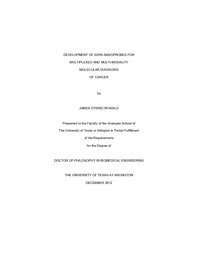
ATTENTION: The works hosted here are being migrated to a new repository that will consolidate resources, improve discoverability, and better show UTA's research impact on the global community. We will update authors as the migration progresses. Please see MavMatrix for more information.
Show simple item record
| dc.contributor.author | Nyagilo, James Otieno | en_US |
| dc.date.accessioned | 2014-03-10T21:03:41Z | |
| dc.date.available | 2014-03-10T21:03:41Z | |
| dc.date.issued | 2014-03-10 | |
| dc.date.submitted | January 2012 | en_US |
| dc.identifier.other | DISS-12068 | en_US |
| dc.identifier.uri | http://hdl.handle.net/10106/24019 | |
| dc.description.abstract | Importance of cancer diagnosis and staging through molecular biomarker detection is evident in the increasing number of molecular biomarkers being discovered that are associated with specific cancers types with their role in disease severity and progression being elucidated. Development of molecular imaging modalities capable of simultaneously detecting multiple molecular biomarkers will have a major impact on research, detection, diagnosis, treatment and monitoring of cancer. Combining molecular imaging with high resolution structural imaging can potentially deliver a cancer diagnostic imaging platform with superior resolution and sensitivity. Nanotechnology, specifically in the form of functionalized metal nanoparticles exhibit unique chemical and electromagnetic properties that may be exploited to develop targeted multimodality contrast agents for combined molecular detection and structural imaging platforms.The main objective this research was the development of nanoprobes that would enable sensitive and targeted multiplexed molecular detection of cancer biomarkers coupled with high resolution anatomical imaging of tumors. The nanoprobes were composed of gold nanoparticle cores which enhanced Raman scattering of molecules (Raman reporter) adsorbed on them by upto seven orders of magnitude through the process called surface enhanced Raman scattering (SERS). Multiple Raman reporters are distinguishable in mixture due to the molecular specificity of each individual Raman spectrum allowing for multiplex detection. SERS nanoprobes enabled multi-modality imaging by combining optical imaging and X-ray computed tomography (CT) taking advantage of high sensitivity of surface enhanced Raman spectroscopy (SERS) and whole body imaging capability of CT. Targeted detection was achieved by functionalization of the SERS nanoprobes with high affinity ligands (antibody and peptides).A modular Raman instrument was designed and fabricated. The modular nature of the Raman instrument meant it could be integrated with a microscope or used as a stand-alone instrument for detection of SERS nanoprobes in vitro or in small animals respectively. Eleven SERS nanoprobes with distinct Raman spectral signature were developed. It was experimentally determined that quasi-spherical gold nanoparticles with an effective diameter of 65.6±6.4 nm yielded the highest SERS signal. A subset of these probes was selected for target molecular imaging (in vitro and in vivo). In vitro studies were conducted using glioblastoma astocytic (U87-MG) cells and prostate cancer cell lines (C4-2 and PC-3). SERS nanoprobes evaluated for target specific detection of cancer biomarkers displayed specificity. Cells labeled with targeted SERS nanoprobes recorded signal intensities up to one order of magnitude more than cells labeled with non-targeted SERS nanoprobes. Quantitative evaluation of four simultaneous detected SERS nanoprobes was demonstrated in U87-MG cells. Longitudinal in vivo studies were conducted in xenograft tumor model and an orthotropic tumor model to evaluate SERS nanoprobes for multimodality SERS/CT imaging. SERS nanoprobes displayed significant X-ray attenuation and were detectable subcutaneously and in excised tissue using SERS spectroscopy. Taken together, the results obtained suggest that SERS nanoprobes are versatile and robust contrast agents usable for multiplexed, multimodality molecular imaging of tumor. | en_US |
| dc.description.sponsorship | Dave, Digant P. | en_US |
| dc.language.iso | en | en_US |
| dc.publisher | Biomedical Engineering | en_US |
| dc.title | Development Of SERS Nanoprobes For Multiplexed And Multi-modality Molecular Diagnosis Of Cancer | en_US |
| dc.type | Ph.D. | en_US |
| dc.contributor.committeeChair | Dave, Digant P. | en_US |
| dc.degree.department | Biomedical Engineering | en_US |
| dc.degree.discipline | Biomedical Engineering | en_US |
| dc.degree.grantor | University of Texas at Arlington | en_US |
| dc.degree.level | doctoral | en_US |
| dc.degree.name | Ph.D. | en_US |
Files in this item
- Name:
- Nyagilo_uta_2502D_12068.pdf
- Size:
- 4.845Mb
- Format:
- PDF
This item appears in the following Collection(s)
Show simple item record


